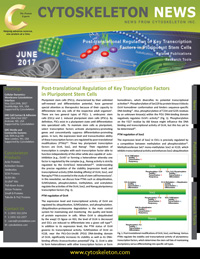June Newsletter: Posttranslational Regulation of Key Transcription Factors in Pluripotent Stem Cells
- By Cytoskeleton Inc. - Signal-Seeker News
- Jun 13, 2017

Pluripotent stem cells (PSCs), characterized by their unlimited self-renewal and differentiation potential, have garnered special attention as therapeutics because of their capacity to differentiate into any cells of the respective adult organism1. There are two general types of PSCs: 1. embryonic stem cells (ESCs) and 2. induced pluripotent stem cells (iPSCs). By definition, PSCs exist in a pluripotent state until differentiation into specialized cells. To maintain stem cells as pluripotent, select transcription factors activate pluripotency-promoting genes and concomitantly suppress differentiation-promoting genes. In turn, the expression level and transactivation ability of these transcription factors are regulated by post-translational modifications (PTMs)2,3. Three key pluripotent transcription factors are Oct4, Sox2, and Nanog3. Their regulation of transcription is complex with each transcription factor able to function independently of the other while also capable of auto-inhibition (e.g., Oct4)4 or forming a heterodimer whereby one factor is regulated by the complex (e.g., Nanog activity is strictly regulated by the Oct4/Sox2 heterodimer)5,6. Understanding the precise regulation of the stability (expression level) and transcriptional activity (DNA-binding affinity) of Oct4, Sox2, and Nanog by PTMs is essential in the study of stem cell homeostasis7.
Click to read more
Also included in this newsletter:
- Signal Seeker™ Kits, PTM Antibodies, Beads, Spirochrome™ Live Cell Imaging Probes
- Related Publications

